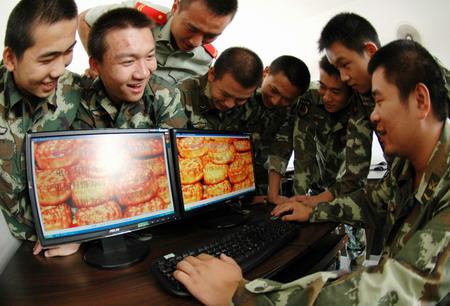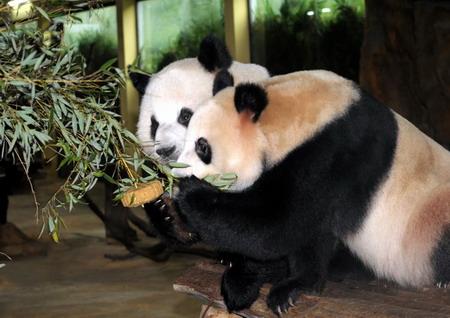
Members of the People's Armed Police firefighting unit stationed in Yuhuan county, Zhejiang province, send e-mooncakes to their families and friends on Tuesday to celebrate the Mid-Autumn Festival. [Jiang Yongbing / for China Daily]
Traditional treat goes green as ornate wrapping reduced
BEIJING - For centuries, it was the quintessential symbol of China's Mid-Autumn Festival, but in recent years it has become a calling card of waste, extravagance and obsequiousness.
But this year - thanks to new packaging rules - the mooncake is returning to a more modest tradition and going green.
Stories of extravagance were easy to come by with mooncakes reportedly placed in gilded or jewelry-encrusted boxes, coupled with brand-name watches, wines, and even gold Buddha statuettes as luxury gifts for bosses, officials, and friends. And the price of a box could be as high as 10,000 yuan ($1,490).
However, under regulations introduced in April by China's Standardization Administration, no more than three layers of food packaging are allowed and it must not exceed 12 percent of the sale price.
The regulations appear to have exerted a major influence on the mooncake market, which peaks on Wednesday when the festival falls.
No reports of exorbitantly priced, over-packaged mooncakes had appeared in China's major cities in the run-up to the festival.
Supermarket shelves displayed "slimmer" mooncakes, shorn of excessive packaging and ornate decorations.
"Mooncakes have less wrapping compared to last year and more are in recyclable paper boxes rather than metal ones," said a Wal-Mart salesperson in Beijing.
The tie-in luxuries and sky-high price tags are also absent. In a Beijing Carrefour supermarket, a well-designed box of six to 10 mooncakes rarely exceeded 500 yuan.
Many supermarkets witnessed the appeal of mooncake stands selling a cheaper, simpler packaged version.

A panda at Xiangjiang Safari Park in Guangzhou, Guangdong province, savors his mooncake treat on Tuesday ahead of the Mid-Autumn Festival. Liu Dawei / Xinhua
And it is not just the packaging that is changing. Younger people are increasingly shunning the traditional, unhealthy variety. Two weeks before the festival, Luo Xiaoyu, a regular online shopper, came across DIY mooncakes at taobao.com, China's largest consumer e-commerce website.
She ordered six for her father with characters saying "Thanks, dad".
Romantic messages are also popular with characters proclaiming "I love you" in big demand. Shop owner Xiao Feizao said he sold 17 DIY packages the week before the festival, charging 88 yuan for four pieces. Customers had to submit their particular messages or patterns three days in advance.
One online shop based in Shaoxing, Zhejiang province, claimed all their DIY mooncakes were made at a well-known hotel, guaranteeing their quality. Photos of family and friends can also be included in the DIY package, priced at 168 yuan.
The DIY mooncakes are not only more creative but also healthier.
The traditional treat, rich in eggs and sweet bean paste, has a high fat content which may be out of step with today's health-conscious lifestyle.
Taobao customers can opt for untraditional ingredients, including yogurt, jelly and fat-free ice-cream as well as pineapple, durian and yam.
While luxury boxes may not be as prominent this year there is not much change to the Mid-Autumn "gift culture" at the core of the excess.
"It has become a custom we tiredly follow," said one customer surnamed Liu, referring to the practice of sending expensive mooncakes to superiors and important friends.
In 2009 alone, China produced 250,000 tons of mooncakes, and wrapping paper consumed more than 6,000 trees, according to the People's Daily website.
Until the Chinese start to question the time-honored but outdated gift-sending mentality and encourage better packaging and recycling standards, Mid-Autumn will continue to be a time of wasteful over-consumption.
Xinhua contributed to this story.





